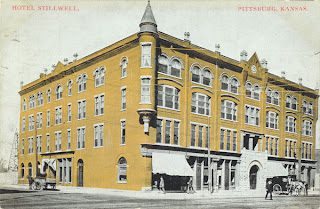The History of Thurber in 12 Objects: A Taste of Thurber

by Lea Hart

leaflet.
Jacobson Collection
When friends and family gather together for the holidays they usually gather around food. With the holidays approaching we decided to bring out an artifact that families still use today: a recipe. Leaflet No. 66 “Rabbit Recipes” from the U.S. Department of Agriculture made its way into a Thurber household and we are willing to bet that more than one family made its recipes. The recipes inside this booklet range from a broiled rabbit with lattice potatoes (now known as waffle fries) to the less popular rabbit liver paste. Many in Thurber supplemented their household by adding some kind of food production, whether it was a vegetable garden or a small chicken coop. Those who didn’t raise their own animals would trap them for food and then for pelts. Regardless of the game used for holiday meals, food still played an important role in festive celebrations.
Holiday food traditions relied on what was available locally. In our research, we have found holiday menus that include game such as quail, red duck, and even oysters. While oysters probably don’t show up on your holiday table today, the Texas Pacific Mercantile and Manufacturing Company supplied Thurber with them weekly while in season. One consistent holiday staple from the past to today seems to be cranberries. Cranberry growers harvest their crop from September to mid-November making them a perfect addition to any Thanksgiving menu, showing up on menus well before 1900. The popularity of cranberries grew when Marcus L. Urann began selling them nationwide as canned jelly in 1941. (If you need some holiday trivia, Urann later convinced other cranberry farmers to join a cooperative which became the National Cranberry Association the Association changed its name to Ocean Spray in 1957.)

While the core of holiday meals seems to be fairly standard, the true difference amongst meals lies in social classes. The holiday fare in the homes of Thurber’s upper echelon featured multiple courses avoiding the foreign foods brought by local immigrants. Thurber’s white-collar families stuck to more traditional American holiday meals like turkey, dressing, fresh vegetables, and a few desserts to pick from. On the other hand, coal mining families in the area would typically have a more basic meal consisting of a meat and vegetable, with one or two sides and a dessert. Immigrant families added a taste of home to their holiday celebrations with foods from their culture. Italian immigrants would have added a seafood pasta dish while Polish immigrants may have made pierogis reminding them of the family and friends they had with them in Thurber as well as those still back home.
Regardless of whether rabbit, turkey, or oysters took center stage, food, family, and fun were still the themes of the holidays. Even in the toughest of times Thurber’s citizens still gathered around a table with loved ones to celebrate the season. Much like today, Thurber residents gave thanks for what they had while digging into a home-cooked holiday meal.
If you’re interested in adding rabbit to your holiday menu you can look through this leaflet online through the National Archives: https://archive.org/details/rabbitrecipes66yeat/page/n1
Speaking of food, drop by the Gordon Center this holiday season for our events with free food! Join us on Sunday, December 2, from 2:00 pm-4:00 pm for Cookies with Santa. Share a cookie with the man in red while getting your photo taken. Then join us on Saturday, December 8, at 6:30pm as we welcome the Irish Rogues band out for an evening of live music, food, and fellowship. Both of these events are free and no reservations are required.
Happy Holidays!





